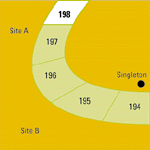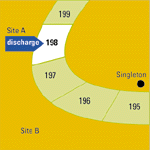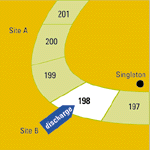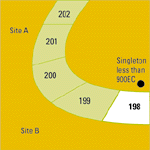How the Hunter River Salinity Trading Scheme works
Salty water is only discharged when there is a lot of low salt, fresh water in the river. Every 2 years, a credit auction is conducted, where people can trade their salt discharge credits. People can only discharge the amount that their credits allow.
The central idea of the scheme is to only discharge salty water when there is lots of low salt, fresh water in the river.
This is when the river can best handle salt discharges because:
- large amounts of fresh water dilute the saltier discharge so the impact on the river is not as great
- through careful control, the mixture of river and discharge water can be kept fresh to meet water quality standards.
Going with the flow
Monitoring points along the river are used to measure whether the river is in low flow, high flow or flood flow.
When the river is in:
- low flow, no discharges are allowed
- high flow, limited discharge is allowed, controlled by a system of salt credits. The amount of discharge allowed depends on the ambient salinity in the river, so it can change daily. The total allowable discharge is calculated so that the salt concentration does not go above 900 µS/cm in the middle and lower sectors of the river or above 600 µS/cm in the upper sector.
- flood, credits are not required for discharges as long as the salt concentration does not go above 900 µS/cm. All scheme participants must also comply with the discharge limits on their environment protection licences. The river flow thresholds for flood events under the scheme have been set so that the salinity target is protected.
Amount of salt that can be discharged
WaterNSW is the Service Co-ordinator for the Hunter River Salinity Trading Scheme and:
- operates a real-time water monitoring system in the Hunter River Catchment
- conducts river flow modelling
- operates a River Register.
Data collected and the modelling of river flows is then used to determine the amount of salt that can be lawfully discharged to the Hunter River during high river flows.
WaterNSW’s River Register is maintained on a dedicated website and is used to notify participants of the scheme when they can discharge, the amount of salt that can be discharged, and the start and end times for each authorised discharge.
View the real time data at Hunter River Register.
River divided into 'blocks'
The water in the river is nominally divided into numbered blocks. A block is a section of water that flows past Singleton in a day. So, block '2023-198' is the block of water that will flow past Singleton on the 198th day of 2023 (17 July). This block of water will flow past other points on the river on different days.
For each block, the scheme operators continually monitor the flow level and the ambient salinity and then calculate how much salt (if any) can be added to the block ('Total Allowable Discharge') so that salinity stays under the target.
The river is divided into numbered blocks. For example, block '2023-198' will pass Singleton on the 198th day of 2010 (17 July). In this example, suppose block 198 could hold 112 tonnes of salt.
On 15 July, block 198 passes Site A. With 20 credits, Site A could discharge 2.24 tonnes (112 x 20 x 0.1%).
On 16 July, block 198 passes Site B. With 45 credits, Site B could discharge 5.04 tonnes (112 x 45 x 0.1%). If Site A did not discharge, it could trade 20 credits to Site B which could then discharge 65 credits of salt or 7.28 tonnes (112 x 65 x 0.1%).
On 17 July, block 198 passes Singleton with salt concentration less than 900 µS/cm.
Contact us
- Email: [email protected]
- Phone: 131 555
More information
Credits
Scheme management




